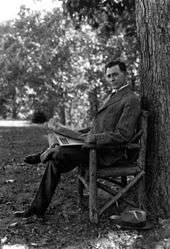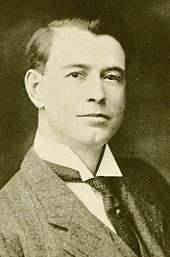Key Pittman
| Key Pittman | |
|---|---|
|
Pittman in 1915 | |
| United States Senator from Nevada | |
|
In office January 29, 1913 – November 10, 1940 | |
| Preceded by | William A. Massey |
| Succeeded by | Berkeley L. Bunker |
| President pro tempore of the United States Senate | |
|
In office March 4, 1933 – November 10, 1940 | |
| Preceded by | George H. Moses |
| Succeeded by | William H. King |
| Chairman of the United States Senate Committee on Foreign Relations | |
|
In office March 4, 1933 – November 10, 1940 | |
| Preceded by | William E. Borah |
| Succeeded by | Walter F. George |
| Personal details | |
| Born |
Key Denson Pittman September 12, 1872 Vicksburg, Mississippi |
| Died |
November 10, 1940 (aged 68) Reno, Nevada |
| Political party | Democratic |
| Spouse(s) | Mimosa Pittman (née Gates) |
| Profession | Lawyer |
Key Denson Pittman (September 12, 1872 – November 10, 1940) was a United States Senator from Nevada, serving eventually as its president pro tempore and its chairman of the Committee on Foreign Relations. He was a Democrat.
Biography
Early years
Pittman was born in Vicksburg, Mississippi, in 1872. He had a younger brother Vail, who would later serve as Governor of Nevada.[1]
Pittman was educated by private tutors and at the Southwestern Presbyterian University in Clarksville, Tennessee. He studied law, then later became a lawyer. In 1897, Pittman joined in the Klondike Gold Rush and worked as a miner until 1901.
Pittman moved to Tonopah, Nevada, in 1902 and continued the practice of law. He represented Nevada at the St. Louis Exposition, the Lewis & Clark Centennial Exposition, and the National Irrigation Congress.
Political career

In 1910, he made an unsuccessful run for the Senate. Later, he was elected as a Democrat to the Senate in 1913 to fill the vacancy caused by the death of George S. Nixon, and served until his death in 1940.
Between 1933 and 1940, during the Presidency of Franklin D. Roosevelt, Pittman was the chairman of the powerful Committee on Foreign Relations and a member of the Committee on Territories and the Committee on Industrial Expositions. In addition, during those years Pittman was also President pro tempore of the United States Senate.
Among his legislation is the Pittman–Robertson Wildlife Restoration Act of 1937 which set up a formula for federal sharing of ammunition tax revenue for establishing state wildlife areas. The program is still in effect. The Key Pittman Wildlife Management Area near Hiko, Nevada, which encompasses the Frenchy and Nesbitt Lakes, is named in his honor.
Death and legacy
It was rumored for years that Pittman died before his final election in 1940, and that Democratic party leaders kept the body in Reno's Riverside Hotel[2] bathtub full of ice until he was reelected so Governor Edward Carville, a fellow Democrat, could appoint a replacement. While the rumor was false the truth was, as former Nevada State Archivist Guy Rocha wrote, "just as disreputable". Pittman suffered a severe heart attack just before the election on November 5, and two doctors told his aides before the election that death was imminent. To avoid affecting the election, the party told the press that the senator was hospitalized for exhaustion and that his condition was not serious. Pittman died on November 10 at the Washoe General Hospital in Reno, Nevada.[3]
Several pieces of legislation bore his name, including the Pittman Act of 1918 and the Pittman–Robertson Federal Aid in Wildlife Restoration Act of 1937.
The Pittman section of the Alaska Railroad, more commonly known today as the community of Meadow Lakes west of Wasilla, was also named for him.[4] Pittman Road runs north from its intersection with the George Parks Highway at "downtown" Meadow Lakes.
In 1941 by his wife donated Pittman's papers to the Library of Congress. She temporarily withdrew them in 1942. They were returned to the Library by the Gates family in 1954.[5]
Footnotes
- ↑ "Nevada Governor Vail Montgomery Pittman". National Governors Association. Retrieved October 6, 2012.
- ↑ http://archive.rgj.com/article/20130616/COL0701/306160045/Guy-Rocha-Sen-Pittman-really-put-ice-
- ↑ Rocha, Guy; Myers, Dennis (May 2003). "Myth #88 - Key Pittman on Ice". Sierra Sage. State Library and Archives, Department of Administration, State of Nevada. Retrieved October 3, 2013.
- ↑ Williams, Anita L.; Ewers, Linda D. (2003). Ride Guide to the Historic Alaska Railroad. Anchorage: TurnAgain Products. p. 30. ISBN 0939301016.
- ↑ Brand, Katherine (2011), Key Pittman Papers: A Finding Aid to the Collection in the Library of Congress, Washington, D.C.: Manuscript Division, Library of Congress
Further reading
- Cole, Wayne S. (March 1960). "Senator Key Pittman and American Neutrality Policies, 1933-1940". Mississippi Valley Historical Review. Organization of American Historians. 46 (4): 644–662. doi:10.2307/1886281. JSTOR 1886281.
- Glad, Betty (1986). Key Pittman: The Tragedy of a Senate Insider. New York: Columbia University Press. ISBN 0-231-06112-9.
- Israel, Fred L. (November 1961). "The Fulfillment of Bryan's Dream: Key Pittman and Silver Politics, 1918-1933". Pacific Historical Review. University of California Press. 40 (4): 359–380. doi:10.2307/3636423. JSTOR 3636423.
- Israel, Fred L. (1963). Nevada's Key Pittman. Lincoln, Nebr.: University of Nebraska Press.
External links
- The Key Pittman papers, including a finding aid, at the Library of Congress
- United States Congress. "Key Pittman (id: P000372)". Biographical Directory of the United States Congress.
- Key Pittman at Find a Grave
| United States Senate | ||
|---|---|---|
| Preceded by William A. Massey |
U.S. Senator from Nevada 1913–1940 |
Succeeded by Berkeley L. Bunker |
| Political offices | ||
| Preceded by William E. Borah Idaho |
Chair of the United States Senate Committee on Foreign Relations 1933–1940 |
Succeeded by Walter F. George Georgia |
| Preceded by George H. Moses New Hampshire |
President pro tempore of the United States Senate March 9, 1933 – November 10, 1940 |
Succeeded by William H. King Utah |


